How to Cite | Publication History | PlumX Article Matrix
K. Ravi Shankar*, S. Das and M. Rudrapal
Sri Sai Aditya Institute of Pharmaceutical Sciences and Research, A.D.B. Road, Surampalem, Peddapuram- 533 437, East Godavari District, Andhra Pradesh India.
ABSTRACT: Ethnomedicinal survey was carried out in remote villages like Jaddangi & Thimmapuram under Rajavommangi range and Devarapalli under Rampachodavaram range of Kakinada forest division, one among three divisions under Rajamundry circle in East Godavari district of Andhra Pradesh. The survey focuses the documentation of indigenous knowledge by identifying, authenticating 28 plant species belonging to 20 different families with some less known ethnomedicinal uses as effective remedies for the local tribes.
KEYWORDS: Ethnomedicine;Tribes; Indigenous; Jaddangi; Thimmapuram; Devarapalli
Download this article as:| Copy the following to cite this article: Shankar K. R, Das S, Rudrapal M. Ethnomedicinal plants used by Konda Reddy, Koya Dora, Konda Kammara, Konda Kapu and Valmiki tribes in East Godavari District of Andhra Pradesh, India. Biosci Biotech Res Asia 2011;8(2) |
| Copy the following to cite this URL: Shankar K. R, Das S, Rudrapal M. Ethnomedicinal plants used by Konda Reddy, Koya Dora, Konda Kammara, Konda Kapu and Valmiki tribes in East Godavari District of Andhra Pradesh, India. Biosci Biotech Res Asia 2011;8(2). Available from: https://www.biotech-asia.org/?p=9552 |
Introduction
The use of plants by different ethnic groups as a source of medicinal agents lies deep in the antiquity1. Nearly 80 % of the world population use traditional medicine, mainly medicinal plants, to cure illness and ailments2. Modern Pharmacopoeias also contain atleast 25 % drugs derived from plants and others which are derived from synthetic analogues of prototype compounds isolated from plants3. The Indian system of medians predominantly uses plants viz Siddha (600), Ayurveda (700), Amchi (600), Unani (700) and Allopathy (30) for their preparations and formulations4. The maximum numbers of medicinal plants are used by folk (tribal people who are the real stewards of the resource) traditions4-5. There are 67.75 million tribal people, 8 % of the total population in India belonging to 573 communities of 227 ethnic groups representing one of the greatest emporia of ethnomedicinal wealth. Andhra Pradesh is home to 33 communities (Lambada, Yarukala, Yanadi, Valmiki, Kondh, Porja, Bagata, KondaKapu, Konda Reddy, Koya Dora, Konda Dora, KondaKammaraetc.), numbered 50,24,104 in the 2001 census officially designated as scheduled tribes (STs) comprising 6.59 % of the state’s population5-6. They have a diverse sociocultural coexisted peaceful life of festivals, celebrations, functions etc. having a divergence and differentiation among various groups in terms of rites, rituals and functions with rare inter-tribal conflicts6. They have sound knowledge on different crude drugs used for their ailments7. There are several reports on ethnomedicinal studies of general ailments like skin diseases, cuts, burns, wounds, backache, diabetes, leucorrhoea, menorrhoea, veterinary diseases, dysentery, cold, cough, scorpion sting, snake bite, insect bite, tumours, anthrax, malaria, worm infestation etc7-8. The knowledge about the tribal medicine is on the way to extinction because of the negligence and the absence of documentation. Traditional medicine practices and ethnomedicinal information play an important role in the scientific research, particularly when the literature and the fieldwork data have been properly evaluated. Documentation of indigenous knowledge on the utilisation of the local plant resources by different ethnic groups or communities is one of the main objectives of ethnomedicinal research9.
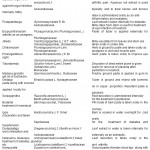 |
Table 1: Ethnomedicinal plants used by the tribal villagers in East Godavari district of Andhra Pradesh.
|
Material and Methods
Study areas10
Jaddangi, Thimmapuram and Devarapalli are situated at 17° 29′ 0.6494″ N latitude & 82° 9′ 0.5033″ E longitude, 17° 22′ 52.8879″ N latitude & 82° 3′ 13.198″ E longitude and 17° 59′ 18.8534″ N latitude & 82° 58′ 49.8317″ E longitude (Figure 1) respectively. Godavari district can be broadly classified into three natural divisions namely Delta, Up and Agency or hill tracts. Rajavommangi (Jaddangi&Thimmapuram) and Rampachodavaram (Devarapalli) constitute delta with a vast expanse of rice-fields, surrounded by plantain, betel, coconut gardens and innumerable palmyrahs, upland and Agency or hill tracts ranging from few meters near sea level to 300 meters rise by gradations of Eastern Ghats at their different parts. There is mostly alluvial soil in delta region like Godavari, sandy clay soil at the tail end portions of river Godavari, red loamy soil in upland and agency area of the district. The major rivers flowing through the division are Godavari, Pampa and Eleru. The region mostly has a tropical climate (hot & humid summer, March-June and rainy, July-Jan) like the rest of the coastal Andhra. Temperatures ranging from 10° C to 48° C and the annual rainfall are about 1280mm.
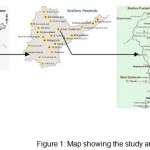 |
Figure 1: Map showing the study areas.
|
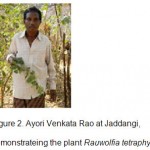 |
Figure 2: AyoriVenkataRao at Jaddangi, demonstrateing the plant Rauwolfiatetraphylla.
|
Method of collection of information and interview
Survey was conducted by recording the information obtained from the questionnaires on medicinal plants with their local names, parts used, mode of preparation and administration with the aged farmers and local tribes. The data were obtained by direct field visit and interviews (Figure 2-8) taken, firstly of individuals like (local old man, school teacher, forest dweller etc.), secondly of groups village chiefs (GramamMusaliVaaru) and thirdly of herbal healers/ local Vaidhyas (AyoriVenkataRao at Jaddangi, Apanakondadoramma at Thimmapuram and S. Rambabu, VanamulikaVyduluat Devarapalli) 11-12. The plants after being identified the specimens had been authenticated in Botanical Survey of India, Hyderabad and incorporated in the herbarium.
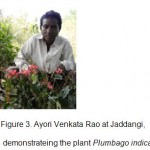 |
Figure 3: AyoriVenkataRao at Jaddangi, demonstrateing the plant Plumbagoindica.
|
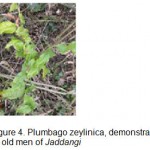 |
Figure 4: Plumbagozeylinica, demonstrated by old men of Jaddangi.
|
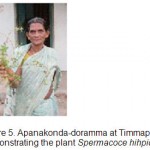 |
Figure 5: Apanakonda-doramma at Timmapuram, demonstrating the plant Spermacocehihpida.
|
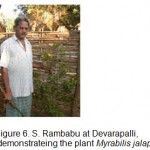 |
Figure 6: S. Rambabu at Devarapalli, demonstrateing the plant Myrabilisjalapa.
|
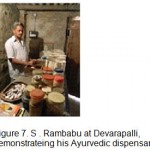 |
Figure 7: S .Rambabu at Devarapalli, demonstrateing his Ayurvedic dispensary.
|
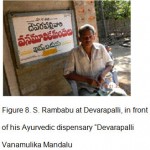 |
Figure 8: S. Rambabu at Devarapalli, in front of his Ayurvedic dispensary “Devarapalli VanamulikaMandalu.
|
Results
In the present survey 28 plant species under 20 different families are enumerated in Table 1 with their vernacular name (Telugu), scientific name/ family and part used & mode of administration. Among all the species, Rauwolfiaserpentina, Andrographispaniculata, Mimosa pudica, Ocimumgratissimum, Tinosporacordifolia, Daturametel, Semicarpusanacardium, Gymnemasylvestre are used in daily life. Plant entirely or by part (tuber, root, bark, leaf, shoot tip, stem, seed, fruits, nut milky and exudates) is either taken internally in the form of pill, paste, powder, decoction, infusion etc. or applied externally as paste.
Discussion
Remedies by total plant species for different ailments like diabetes (3); diabetes & jaundice (2); cough & asthma (3); piles (2); wound healing (2); analgesic in arthritic pain (2), snake bite (1), joint & muscle pain (1), menstrual pain (1);digestive (1); toothache & gum infection (1); eye-sight disorder (1); oxytocic (1); paralysis (1); hypertension (1); worm infestation (1); kidney calculi (1); obesity (1); dysentery (1); anti-anxiety (1) are revealed in the study. A proper analysis and conservation of most of these endangered plant species favouring sustainable use by bringing more medicinal species into cultivation by scientific commercial farming (organic farming, irrigation, harvesting & preservation and marketing) in an attempt to develop awareness of the local people would be of immense help as the life saving remedies for the tribal villagers on the lap of remote hill tracts or agency areas. Hence Pharmacological and phytochemical investigation of these plant species is required to know the accuracy of the therapeutic values for better utilization of the traditional knowledge.
Acknowledgements
The authors (K.R.S, S.D. & M.R.) would like to convey the greatest thanks to Sri N. Satish Reddy, VC of Aditya Educational Institutions for providing laboratory facilities and other needs. They are thankful to the knowledge providers AyoriVenkataRao, Apanakondadoramma, S .Rambabu and other grand old people for revealing their traditional ideas and secrets of healings. They express their sincere thanks to laboratory technicians VelnatiThammanna Dora (under the categoryKoya Dora tribe & the guide for the survey), V. Velankini, J. S. Mahalakshmi for their continuous help. Finally their sincere gratitude goes to Botanical Survey of India Scientist Dr. P. V. Prasanna for authenticating the identity of the plant species.
References
- M Ragunathan, M Solomon. The study of spiritual remedies in orthodox rural churches and traditional medicinal practice in Gondar Zuria district, Northwestern Ethiopia. Phcog J.,3: 1-6 (2009).
- JM Manual, G Emilia, JV Prem. An ethnobotanical survey of medicinal plants commercialized in the markets of La Paz and El Alto, Bolivia. Journal of Ethnopharmacology.97: 337 (2005).
- V Sharma, BD Joshi. Traditional medicines used for health care amongst the local people of Almora district of Central Himalaya in India. Asian Journal of Traditional Medicines.;5: 1-5 (2010).
- DN Tewari. Reports of the task force on conservation and sustainable use of medicinal plants, Planning Commission, Government of India, New Delhi, India (2000).
- JW Prakash, RD Raja, NA Anderson, C Williams, GS Regini, K Bensar, R Rajeev. Ethnomedicinal plants used by Kani tribes of Agasthiyarmalai biosphere reserve, southern Western Ghats.Indian Journal of Traditional Knowledge.,7: 410-413 (2008).
- SL Rao, P Deshingkar, J Farrington. Tribal land alienation in Andhra Pradesh processes impacts and policy concerns. Economic and Political Weekly.30: 1-7 (2006).
- KV Ratnam , RRV Raju. Folk remedies for insect bites from Gundlabrahmeswaram Wild Life Sanctuary, Andhra Pradesh. Indian Journal of Traditional Knowledge.;7: 436-437 (2008).
- KN Reddy, G Trimurthulu, CS Reddy. Medicinal plants used by ethnic people of Medak district, Andhra Pradesh. Indian Journal of Traditional Knowledge.9: 184-190 (2010).
- A Maruthupandian, VR Mohan. Observations of ethnomedicinal plants from Sirumalai hills in Western Ghats of Tamilnadu, India.Journal of Herbal Medicine and Toxicology.4: 1-4 (2010).
- Anonymous. Andhra Pradesh State of Forest Report 2010.Andhra Pradesh Forest Department, Government of AP, Hyderabad, India 2010.
- K Rajendran, P Balaji, MJ Basu. Medicinal plants and their utilization by villagers in southern districts of Tamil Nadu.Indian Journal of Traditional Knowledge.;7: 417-420 (2008).
- SK Dey, A De, S Karmakar, PK De, S Chakraborty, A Samanta, A Mukherjee. Ethnobotanical study in a remote district of West Bengal, India.Pharmbit.,20: 91-96 (2009).

This work is licensed under a Creative Commons Attribution 4.0 International License.





